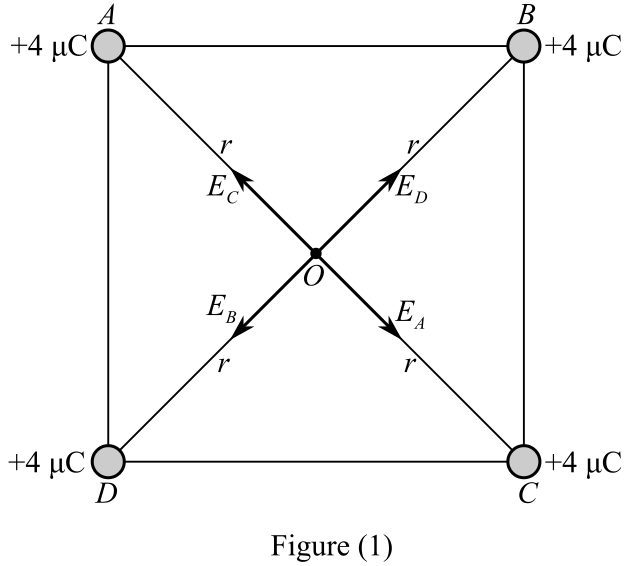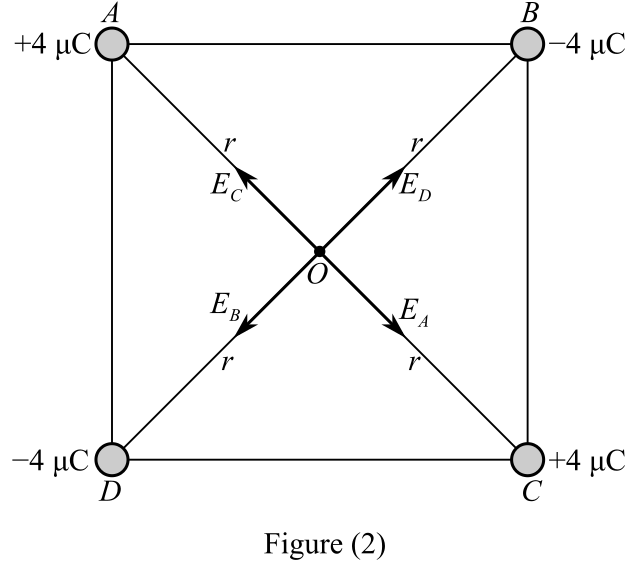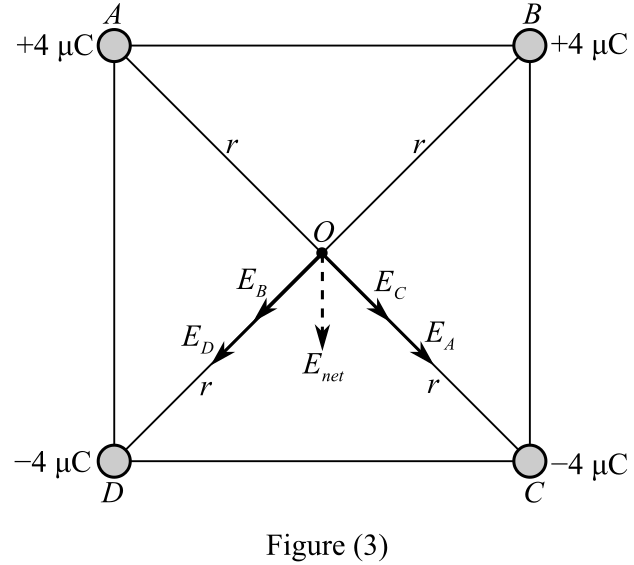
Concept explainers
Four equal-magnitude (4.0
(a)
The electric field at the center of the square, iffour positively charged charges, having magnitude of each is
Answer to Problem 42SP
Solution:
Explanation of Solution
Given data:
The length of each side of the square is
The magnitude of each charge is
Formula used:
Write the expression for the electric field
Here,
Explanation:
In this case, all charges are of equal magnitude and polarity, and are located at the same distance from the center of the square.
Denote the charge by
As all charges are positive, the direction of the electric field shall be outward and away from the charges, as shown in the figure below.
The electric field at the center of the square will the resultant electric filed due to all the electric fields acting on it. Therefore, the electric field at the center of the square will be the resultant of the electric fields due to charges at points A, B, C, and D.

Recall the expression for the electric field.
Refer to the above diagram and write the expression for the electric field at the corners of the square due to all the four-point charges that are placed at the corners of the square.
Write the expression for the electric field due to charges at the point A.
Write the expression for the electric field due to charges at the point B.
Write the expression for the electric field due to charges at the point C.
Write the expression for the electric field due to charges at the point D.
The resultant electric field at the center of the square will be
Substitute
Conclusion:
The electric field at the center of the square if the charges are all positive is
(b)
The electric field at the center of the square if the charges alternate in sign around the perimeter of the square and the magnitude of each charge is
Answer to Problem 42SP
Solution:
Explanation of Solution
Given data:
The length of each side of the square is
The magnitude of each charge is
Formula used:
Write the expression for the electric field
Here,
Explanation:
In this case, all charges are of equal magnitude, however, they are placed such that they alternate in sign around the perimeter of the square. Also, they are located at the same distance from the center of the square.
Denote the charge by
For positivecharges, the direction of the electric field shall be outward and away from the charges, while for negative charges the direction of the electric field shall be toward the charges as shown in the figure below.
The electric field at the center of the square will be the resultant electric filed due to all the electric fields acting on it. Therefore, the electric field at the center of the square will be the resultant of the electric fields due to charges at points A, B, C and D.

The expression for the electric field is given as
Here,
Write the expression for the electric field due to charges at the point A.
Write the expression for the electric field due to charges at the point B.
Write the expression for the electric field due to charges at the point C.
Write the expression for the electric field due to charges at the point D.
The resultant electric field at the center of the square will be
Substitute
Conclusion:
The electric field at the center of the square, if the charges alternate in sign around the perimeter of the square, is
(c)
The electric field at the center of the square if the all the four charges, having magnitude of each as
Answer to Problem 42SP
Solution:
Explanation of Solution
Given data:
The length of each side of the square is
The magnitude of each charge is
Formula used:
Write the expression for the electric field.
Here,
Write the expression for the relation between the length of the diagonal and side of a square
Here,
Write the expression for the net (resultant) electric field
Here,
Explanation:
In this case, all charges are of equal magnitude, however, they are placed such the charges on the top are positive while the charges on the bottom are negative. Also, they are located at the same distance from the center of the square.
Denote the charge by
For positive charges, the direction of the electric field shall be outward and away from the charges, while for negative charges the direction of the electric field shall be toward the charges, as shown in the figure below.
The electric field at the center of the square will be the resultant electric filed due to all the electric fields acting on it. Therefore, the electric field at the center of the sphere will be the resultant of the electric fields due to charges at points A, B, C and D.

Recall the expression for diagonal length of a square.
Here,
Apply the equation mentioned above to determine the distance
Write the expression for distance
Substitute
Write the expression for the electric field.
Here,
Refer to the above diagram and write the expression for the electric field due to charges at A, B, C and D.
Write the expression for the electric field due to charges at the point A.
Write the expression for the electric field due to charges at the point B.
Write the expression for the electric field due to charges at the point C.
Write the expression for the electric field due to charges at the point D.
Recall the expression for the resultant electric field at the center of the square.
The angle between sum of electric field due to C and A, and D and B is
Substitute
Understand that
Substitute
Conclusion:
The electric field at the center of the square if the charges follow the sequence plus, plus, minus, minus around the perimeter of the square is
Want to see more full solutions like this?
Chapter 24 Solutions
Schaum's Outline of College Physics, Twelfth Edition (Schaum's Outlines)
Additional Science Textbook Solutions
Human Physiology: An Integrated Approach (8th Edition)
Fundamentals Of Thermodynamics
Loose Leaf For Integrated Principles Of Zoology
- Why is the following situation impossible? A solid copper sphere of radius 15.0 cm is in electrostatic equilibrium and carries a charge of 40.0 nC. Figure P24.30 shows the magnitude of the electric field as a function of radial position r measured from the center of the sphere. Figure P24.30arrow_forwardFind an expression for the magnitude of the electric field at point A mid-way between the two rings of radius R shown in Figure P24.30. The ring on the left has a uniform charge q1 and the ring on the right has a uniform charge q2. The rings are separated by distance d. Assume the positive x axis points to the right, through the center of the rings. FIGURE P24.30 Problems 30 and 31.arrow_forwardTwo solid spheres, both of radius 5 cm, carry identical total charges of 2 C. Sphere A is a good conductor. Sphere B is an insulator, and its charge is distributed uniformly throughout its volume. (i) How do the magnitudes of the electric fields they separately create at a radial distance of 6 cm compare? (a) EA EB = 0 (b) EA EB 0 (c) EA = EB 0 (d) 0 EA EB (e) 0 = EA EB (ii) How do the magnitudes of the electric fields they separately create at radius 4 cm compare? Choose from the same possibilities as in part (i).arrow_forward
- aA plastic rod of length = 24.0 cm is uniformly charged with a total charge of +12.0 C. The rod is formed into a semicircle with its center at the origin of the xy plane (Fig. P24.34). What are the magnitude and direction of the electric field at the origin? Figure P24.34arrow_forwardA point charge of 4.00 nC is located at (0, 1.00) m. What is the x component of the electric field due to the point charge at (4.00, 2.00) m? (a) 1.15 N/C (b) 0.864 N/C (c) 1.44 N/C (d) 1.15 N/C (e) 0.864 N/Carrow_forwardIs it possible for a conducting sphere of radius 0.10 m to hold a charge of 4.0 C in air? The minimum field required to break down air and turn it into a conductor is 3.0 106 N/C.arrow_forward
- The electric field 10.0 cm from the surface of a copper ball of radius 5.0 cm is directed toward the ball's center and has magnitude 4.0102 N/C. How much charge is on the surface of the ball?arrow_forwardEight small conducting spheres with identical charge q = 2.00 C are placed at the corners of a cube of side d = 0.500 m (Fig. P23.75). What is the total force on the sphere at the origin (sphere A) due to the other seven spheres? Figure P23.75arrow_forwardA solid conducting sphere of radius 2.00 cm has a charge 8.00 μC. A conducting spherical shell of inner radius 4.00 cm and outer radius 5.00 cm is concentric with the solid sphere and has a total charge −4.00 μC. Find the electric field at (a) r = 1.00 cm, (b) r = 3.00 cm, (c) r = 4.50 cm, and (d) r = 7.00 cm from the center of this charge configuration.arrow_forward
- Two solid spheres, both of radius 5 cm. carry identical total charges of 2 C. Sphere A is a good conductor. Sphere B is an insulator, and its charge is distributed uniformly throughout its volume, (i) How do the magnitudes of the electric fields they separately create at a radial distance of 6 cm compare? (a) EA EB= 0 (b) EA EB 0 (c) EA = EB 0 (d) 0EAEB (e) 0 = Ea EB (ii) How do the magnitudes of the electric fields they separately create at radius 4 cm compare? choose from the same possibilities as in part (i).arrow_forwardAssume the magnitude of the electric field on each face of the cube of edge L = 1.00 m in Figure P23.32 is uniform and the directions of the fields on each face are as indicated. Find (a) the net electric flux through the cube and (b) the net charge inside the cube. (c) Could the net charge he a single point charge? Figure P23.32arrow_forwardA solid, insulating sphere of radius a has a uniform charge density throughout its volume and a total charge Q. Concentric with this sphere is an uncharged, conducting, hollow sphere whose inner and outer radii are b and c as shown in Figure P19.75. We wish to understand completely the charges and electric fields at all locations. (a) Find the charge contained within a sphere of radius r a. (b) From this value, find the magnitude of the electric field for r a. (c) What charge is contained within a sphere of radius r when a r b? (d) From this value, find the magnitude of the electric field for r when a r b. (e) Now consider r when b r c. What is the magnitude of the electric field for this range of values of r? (f) From this value, what must be the charge on the inner surface of the hollow sphere? (g) From part (f), what must be the charge on the outer surface of the hollow sphere? (h) Consider the three spherical surfaces of radii a, b, and c. Which of these surfaces has the largest magnitude of surface charge density?arrow_forward
 Physics for Scientists and Engineers: Foundations...PhysicsISBN:9781133939146Author:Katz, Debora M.Publisher:Cengage Learning
Physics for Scientists and Engineers: Foundations...PhysicsISBN:9781133939146Author:Katz, Debora M.Publisher:Cengage Learning Principles of Physics: A Calculus-Based TextPhysicsISBN:9781133104261Author:Raymond A. Serway, John W. JewettPublisher:Cengage Learning
Principles of Physics: A Calculus-Based TextPhysicsISBN:9781133104261Author:Raymond A. Serway, John W. JewettPublisher:Cengage Learning Physics for Scientists and EngineersPhysicsISBN:9781337553278Author:Raymond A. Serway, John W. JewettPublisher:Cengage Learning
Physics for Scientists and EngineersPhysicsISBN:9781337553278Author:Raymond A. Serway, John W. JewettPublisher:Cengage Learning Physics for Scientists and Engineers, Technology ...PhysicsISBN:9781305116399Author:Raymond A. Serway, John W. JewettPublisher:Cengage Learning
Physics for Scientists and Engineers, Technology ...PhysicsISBN:9781305116399Author:Raymond A. Serway, John W. JewettPublisher:Cengage Learning Physics for Scientists and Engineers with Modern ...PhysicsISBN:9781337553292Author:Raymond A. Serway, John W. JewettPublisher:Cengage Learning
Physics for Scientists and Engineers with Modern ...PhysicsISBN:9781337553292Author:Raymond A. Serway, John W. JewettPublisher:Cengage Learning College PhysicsPhysicsISBN:9781285737027Author:Raymond A. Serway, Chris VuillePublisher:Cengage Learning
College PhysicsPhysicsISBN:9781285737027Author:Raymond A. Serway, Chris VuillePublisher:Cengage Learning





